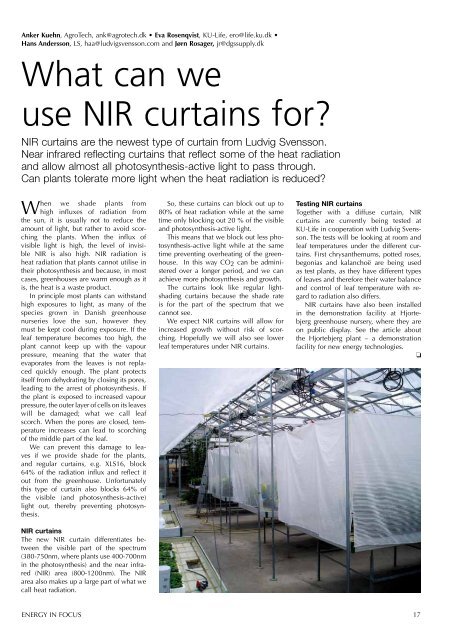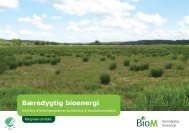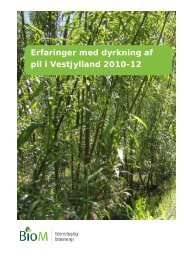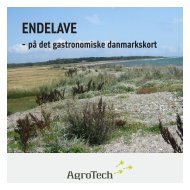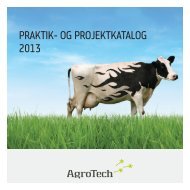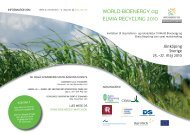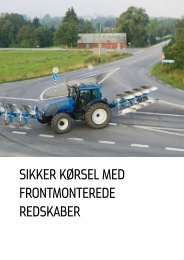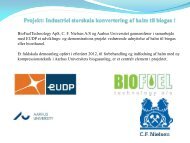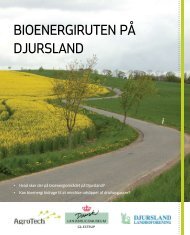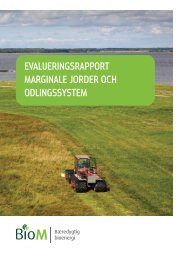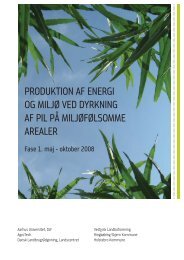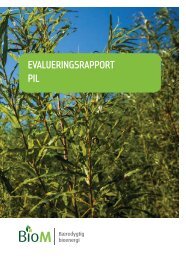Article. Energy in fokus - from Kyoto to Copenhagen. - AgroTech
Article. Energy in fokus - from Kyoto to Copenhagen. - AgroTech
Article. Energy in fokus - from Kyoto to Copenhagen. - AgroTech
You also want an ePaper? Increase the reach of your titles
YUMPU automatically turns print PDFs into web optimized ePapers that Google loves.
Anker Kuehn, <strong>AgroTech</strong>, ank@agrotech.dk • Eva Rosenqvist, KU-Life, ero@life.ku.dk •<br />
Hans Andersson, LS, haa@ludvigsvensson.com and Jørn Rosager, jr@dgssupply.dk<br />
What can we<br />
use NIR curta<strong>in</strong>s for?<br />
NIR curta<strong>in</strong>s are the newest type of curta<strong>in</strong> <strong>from</strong> Ludvig Svensson.<br />
Near <strong>in</strong>frared reflect<strong>in</strong>g curta<strong>in</strong>s that reflect some of the heat radiation<br />
and allow almost all pho<strong>to</strong>synthesis-active light <strong>to</strong> pass through.<br />
Can plants <strong>to</strong>lerate more light when the heat radiation is reduced?<br />
When we shade plants <strong>from</strong><br />
high <strong>in</strong>fluxes of radiation <strong>from</strong><br />
the sun, it is usually not <strong>to</strong> reduce the<br />
amount of light, but rather <strong>to</strong> avoid scorch<strong>in</strong>g<br />
the plants. When the <strong>in</strong>flux of<br />
visible light is high, the level of <strong>in</strong>visible<br />
NIR is also high. NIR radiation is<br />
heat radiation that plants cannot utilise <strong>in</strong><br />
their pho<strong>to</strong>synthesis and because, <strong>in</strong> most<br />
cases, greenhouses are warm enough as it<br />
is, the heat is a waste product.<br />
In pr<strong>in</strong>ciple most plants can withstand<br />
high exposures <strong>to</strong> light, as many of the<br />
species grown <strong>in</strong> Danish greenhouse<br />
nurseries love the sun, however they<br />
must be kept cool dur<strong>in</strong>g exposure. If the<br />
leaf temperature becomes <strong>to</strong>o high, the<br />
plant cannot keep up with the vapour<br />
pressure, mean<strong>in</strong>g that the water that<br />
evaporates <strong>from</strong> the leaves is not replaced<br />
quickly enough. The plant protects<br />
itself <strong>from</strong> dehydrat<strong>in</strong>g by clos<strong>in</strong>g its pores,<br />
lead<strong>in</strong>g <strong>to</strong> the arrest of pho<strong>to</strong>synthesis. If<br />
the plant is exposed <strong>to</strong> <strong>in</strong>creased vapour<br />
pressure, the outer layer of cells on its leaves<br />
will be damaged; what we call leaf<br />
scorch. When the pores are closed, temperature<br />
<strong>in</strong>creases can lead <strong>to</strong> scorch<strong>in</strong>g<br />
of the middle part of the leaf.<br />
We can prevent this damage <strong>to</strong> leaves<br />
if we provide shade for the plants,<br />
and regular curta<strong>in</strong>s, e.g. XLS16, block<br />
64% of the radiation <strong>in</strong>flux and reflect it<br />
out <strong>from</strong> the greenhouse. Unfortunately<br />
this type of curta<strong>in</strong> also blocks 64% of<br />
the visible (and pho<strong>to</strong>synthesis-active)<br />
light out, thereby prevent<strong>in</strong>g pho<strong>to</strong>synthesis.<br />
NIR curta<strong>in</strong>s<br />
The new NIR curta<strong>in</strong> differentiates between<br />
the visible part of the spectrum<br />
(380-750nm, where plants use 400-700nm<br />
<strong>in</strong> the pho<strong>to</strong>synthesis) and the near <strong>in</strong>frared<br />
(NIR) area (800-1200nm). The NIR<br />
area also makes up a large part of what we<br />
call heat radiation.<br />
So, these curta<strong>in</strong>s can block out up <strong>to</strong><br />
80% of heat radiation while at the same<br />
time only block<strong>in</strong>g out 20 % of the visible<br />
and pho<strong>to</strong>synthesis-active light.<br />
This means that we block out less pho<strong>to</strong>synthesis-active<br />
light while at the same<br />
time prevent<strong>in</strong>g overheat<strong>in</strong>g of the greenhouse.<br />
In this way CO2 can be adm<strong>in</strong>istered<br />
over a longer period, and we can<br />
achieve more pho<strong>to</strong>synthesis and growth.<br />
The curta<strong>in</strong>s look like regular lightshad<strong>in</strong>g<br />
curta<strong>in</strong>s because the shade rate<br />
is for the part of the spectrum that we<br />
cannot see.<br />
We expect NIR curta<strong>in</strong>s will allow for<br />
<strong>in</strong>creased growth without risk of scorch<strong>in</strong>g.<br />
Hopefully we will also see lower<br />
leaf temperatures under NIR curta<strong>in</strong>s.<br />
Test<strong>in</strong>g NIR curta<strong>in</strong>s<br />
Together with a diffuse curta<strong>in</strong>, NIR<br />
curta<strong>in</strong>s are currently be<strong>in</strong>g tested at<br />
KU-Life <strong>in</strong> cooperation with Ludvig Svensson.<br />
The tests will be look<strong>in</strong>g at room and<br />
leaf temperatures under the different curta<strong>in</strong>s.<br />
First chrysanthemums, potted roses,<br />
begonias and kalanchoë are be<strong>in</strong>g used<br />
as test plants, as they have different types<br />
of leaves and therefore their water balance<br />
and control of leaf temperature with regard<br />
<strong>to</strong> radiation also differs.<br />
NIR curta<strong>in</strong>s have also been <strong>in</strong>stalled<br />
<strong>in</strong> the demonstration facility at Hjorte-<br />
bjerg greenhouse nursery, where they are<br />
on public display. See the article about<br />
the Hjortebjerg plant – a demonstration<br />
facility for new energy technologies.<br />
<br />
ENERGY IN FOCUS 17


